The NVIDIA GTC 2018 Keynote Live Blog
by Ryan Smith & Nate Oh on March 27, 2018 11:50 AM EST
12:02PM EDT - I'm here at the San Jose Convention Center for NVIDIA's 2018 GPU Technology Conference
12:03PM EDT - Kicking off this first full day of events is of course NVIDIA CEO Jen-Hsun Huang's keynote address, which always moves fast and is packed with major NVIDIA announcements
12:04PM EDT - The show is set to start at 9am, but it typically runs 10 minutes or so late
12:05PM EDT - Jen-Hsun has taken away the tables for the press this year, so we're all doing this on lap-tops, literally
12:05PM EDT - And here we go
12:07PM EDT - It's a long song, it seems
12:07PM EDT - “This is the greatest show”
12:08PM EDT - Joining me remotely today is AnandTech GPU Editor Nate Oh, who is covering photos
12:08PM EDT - WiFi connectivity at GTC is always spotty. But this year is proving worse than most
12:10PM EDT - Okay, and now the song is over and a video is rolling
12:10PM EDT - I think this may be an updated version of last year's video?
12:12PM EDT - "I am AI"
12:12PM EDT - And Jen-Hsun has now taken the stage
12:14PM EDT - Today's topics: amazing graphics, amazing science, amazing AI, and amazing robots
12:14PM EDT - First topic: graphics
12:14PM EDT - Looks like we're starting with photorealism and ray tracing
12:15PM EDT - (Captain Phasma may not have done anything of importance in the movies, but she sure shows up a lot in ray tracing talks thanks to that reflective chrome suit)
12:16PM EDT - Jen-Hsun is noting the amount of compute time required to render a single image for a film, never mind all of the frames
12:17PM EDT - NVIDIA wants to further close the gap between rasterization and ray tracing
12:18PM EDT - Jen-Hsun is going over all the tricks currently used to fake lighting in games/rasterization. Pre-baked lighting, AO shaders, etc
12:19PM EDT - As opposed to real reflections, real transparencies, real global illumination, etc
12:25PM EDT - Sorry for the interruption. WiFi is trying its best to die
12:26PM EDT - Jen-Hsun and his tech are going over everything involved in the Star Wars ray tracing tech demo from last week
12:27PM EDT - NVIDIA and ILM do this in real time on a single DGX Station. So 4 GPUs
12:27PM EDT - Confirming that this is in real time, moving the camera around to prove it
12:28PM EDT - Announcing NVIDIA RTX technology
12:28PM EDT - Perhaps we'll get a more hardware-focused look at last week's RTX announcement?
12:29PM EDT - Announciung Quadro GV100
12:30PM EDT - API support: DirectX Raytracing, NVIDIA OptiX, and Vulkan
12:30PM EDT - Quadro GV100 is the "world's largest GPU"
12:31PM EDT - (It looks like the same size as always)
12:31PM EDT - Confirming NVLink 2 support. 2 connectors on the board
12:31PM EDT - Discussing how two GV100 cards can be teamed together, including shared memory pools
12:32PM EDT - 5120 CUDA cores. 640 tensor cores
12:32PM EDT - 32GB of HBM2 memory
12:33PM EDT - Now back to rendering technology
12:37PM EDT - “The more GPUs to buy, the more money you save”
12:38PM EDT - Discussing the cost benefits of GPU rendering versus a large CPU farm
12:38PM EDT - Now talking about the rise of GPU computing
12:39PM EDT - Discusisng how GPU's have become much more flexible over the years
12:40PM EDT - "We're at the tipping point": of GPU computing
12:41PM EDT - The SJC Convention Center is a packed house. 8500 registrations
12:42PM EDT - "The world needs larger computers"
12:43PM EDT - Recapping various supercomputers and what projects they've worked on
12:44PM EDT - Fermi vs. Volta
12:45PM EDT - This is supposed to be a 5 year comparison, but I'd note that the Kepler-based Tesla K20 launched more than 5 years ago
12:46PM EDT - Moral of the story? GPU perf has thus far grown faster than Moore's Law (in most case)
12:50PM EDT - "The more you buy, the more you save" once again. This time reflecting the pace of the Tesla line and Volta V100 servers
12:50PM EDT - (WiFi gets overloaded, dies, dumps the problem machines, and comes back)
12:50PM EDT - Now talking about medical applications of GPU computing via medical imaging
12:52PM EDT - NVIDIA Project Clara. A "medical imaging supercomputer"
12:54PM EDT - Demo time
12:54PM EDT - EKG of a heart
12:55PM EDT - Showing how NVIDIA is taking the scan data off of a 15 year old machine and enhancing the resulting imagery
12:55PM EDT - Using algorithms to produce a volumetric representation
12:56PM EDT - Inferring where the left ventrical is in 3D basedon the 2D data
12:58PM EDT - Medical instruments have a long life cycle. NVIDIA wants to increase their usefulness by post-processing the data on GPUs to infer more data from the scans
12:59PM EDT - Shifting gears to AI
01:00PM EDT - "Deep learning has revolutionized modern AI"
01:01PM EDT - NVIDIA is doing everything they can to expand the platform (and capture the market)
01:03PM EDT - Volta V100 is getting a memory bump to 32GB of HBM2 per card
01:03PM EDT - Available now
01:03PM EDT - DGXs are getting the upgraded cards as well
01:03PM EDT - This isn't a new SKU to sit beside the 16GB SKUs. Tesla V100 is being replaced with 32GB cards in the market wholesale
01:05PM EDT - "The world wants a gigantic GPU"
01:05PM EDT - "The world's largest GPU"
01:05PM EDT - This is definitely a misnomer
01:05PM EDT - 16 Tesla V100s in a cluster together
01:06PM EDT - All connected together via a new item called the NVSwitch
01:06PM EDT - Unified memory space
01:06PM EDT - So this is all 16 cards in one system
01:07PM EDT - Aggregate HBM2 capacity of 512GB
01:07PM EDT - 2 PFLOPs
01:07PM EDT - That's 2 PFLOPs of tensor core throughput
01:09PM EDT - A new NVIDIA DGX server. "The world's largest GPU"
01:09PM EDT - NVSwitch has wB transistors, made on TSMC 12nm FFN
01:10PM EDT - 18 NVLInk ports per switch
01:10PM EDT - 900GB of full duplex bandwidth on a switch
01:10PM EDT - 12 switches on the new server
01:10PM EDT - Every GPU can communicate at 300GB/sec. 20x the bandwidth of PCIe
01:11PM EDT - "It's not a network. It's a switch" a fabric, to be precise
01:11PM EDT - So all the NVLink benefits of shared memory, coherency, etc are retained
01:11PM EDT - DGX-2
01:11PM EDT - 8x EDR IB/100 GigE
01:11PM EDT - 10 Kilowatt power consumption!
01:12PM EDT - 350 lbs
01:12PM EDT - 16 V100s backed by a pair of Xeon Platinum CPUs
01:12PM EDT - "No human can lift it"
01:14PM EDT - Uses a new NVLink plane card to connect two trays of Tesla V100s
01:16PM EDT - “This is what an engineer finds beautiful”
01:16PM EDT - (NV apparently filmed the blow-apart animation using stop-motion rather than CGI. Why? Because they could)
01:16PM EDT - 10x faster than DGX-1 in 6 months
01:17PM EDT - How much should we charge?
01:18PM EDT - Answer: $1,500,000
01:18PM EDT - Available in Q3
01:18PM EDT - Oh, no, $1.5M was a joke
01:18PM EDT - $399K is the real price
01:22PM EDT - "We are all in on deep learning"
01:22PM EDT - Comparing AlexNet training time on the GTX 580 versus the DGX-2
01:22PM EDT - Days versus minutes
01:23PM EDT - Now talking about NVIDIA's software container service, the NVIDIA GPU Cloud
01:24PM EDT - 30 different containers
01:24PM EDT - Google, Alibaba, AWS, and more support the containers
01:25PM EDT - "Plaster"
01:26PM EDT - "We need a computing model that dramatically reduces the energy requirements"
01:29PM EDT - “Inference is complicated”
01:29PM EDT - (This is an understatement, to ssy the least)
01:30PM EDT - Announcing a new batch of tools and libraries
01:30PM EDT - TensorRT 4.0
01:30PM EDT - Deep TensorFlow integration
01:31PM EDT - A fully trained network can be run right on NV's architecture in an optimized fashion
01:31PM EDT - TensorRT also adds support for the Onyx format and WinML
01:33PM EDT - Now discussing the various acceleration factors versus CPU-only execution
01:33PM EDT - (They're all big integers)
01:34PM EDT - "We're going to save a lot of money"
01:34PM EDT - Kubernetes on NVIDIA GPUs
01:34PM EDT - IMost people here don't know what Kubernetes is)
01:35PM EDT - An orchestration layer to allocate work over a datacenter
01:36PM EDT - Kubernetes is now GPU-aware, allowing large tasks to be allocated over multiple servers and supported at multiple cloud services
01:38PM EDT - Demoing TensorRT on one V100
01:38PM EDT - Now on 8 servers via Kubernetes in real time
01:39PM EDT - Not an 8x speedup, but still a lot faster
01:40PM EDT - Saturn V is up to 660 DGX-1 nodes
01:41PM EDT - Saturn V is up to 660 DGX-1 nodes
01:42PM EDT - Demoing resiliency
01:43PM EDT - And that's a wrap on AI inference
01:44PM EDT - Titan V is still officailly out of stock
01:44PM EDT - NV is working on it
01:45PM EDT - Now heaping praise on the NVIDIA Research group
01:46PM EDT - JHH's favorite project? Noise-to-noise denoising of ray tracing
01:48PM EDT - Another project: using GANs to synthesize realistic environments
01:50PM EDT - And now time to talk about autonomy and NV's self-driving projects
01:50PM EDT - "It's hard, it's really, really hard"
01:50PM EDT - But "this work is vitally important" as well
01:52PM EDT - Sensor fusion can overcome the limitations of individual sensor types
01:52PM EDT - But it's a hard problem. One that NV is working on
01:53PM EDT - Recapping the DRIVE platform and the end-to-end training process
01:54PM EDT - Recapping the DRIVE platform and the end-to-end training process
01:55PM EDT - “Simulation is going to be the foundation of success”
01:55PM EDT - The NVIDIA Perception Infrastructure
01:55PM EDT - Labeling 1mil images per month
01:56PM EDT - The end product of the system is networks
01:58PM EDT - (Ultimately this seems to be NV's response to last week's self-driving Uber incident)
01:58PM EDT - (Which, I hear from a source, was using NVIDIA DRIVE hardware; no idea whose algorithms though)
02:00PM EDT - All cars are mapping cars
02:01PM EDT - "We're going to work on this for another 2 or 3 years before we ship in volume cars"
02:01PM EDT - Now rolling a video
02:07PM EDT - Monitoring not only the car but the passengers as well
02:08PM EDT - Recapping the DRIVE hardware roadmap
02:09PM EDT - Both Xavier and Pegasus in production by the end of the year
02:09PM EDT - ASIL-D functional safety
02:10PM EDT - "We're not stopping here"
02:10PM EDT - Next generation DRIVE: Orin
02:11PM EDT - Get Pegasus down to a couple of small Orins
02:13PM EDT - Jen-hsun is now making the point that it would take many thousands of test cars to get to a fraction of the real world miles driven by humans
02:13PM EDT - Which makes it hard to do enough testing
02:13PM EDT - The solution? Simulation
02:14PM EDT - This looks to be a continuation of NV's simulation-driven training program revealed at GTC 2017
02:15PM EDT - The simulation needs to offer enough fidelity to properly tax the sensors
02:16PM EDT - Now showing the DRIVE system view
02:18PM EDT - Can use the artificial nature of the sim to ensure weird, atypical situations are much more frequent than in real life
02:20PM EDT - NVIDIA DRIVE Sim and Constellation, an AV validation system
02:20PM EDT - 10K Constallations drive 3B miles per year
02:22PM EDT - 370 partners on DRIVE
02:22PM EDT - Cars are the first, but robots are coming
02:23PM EDT - (Jen-Hsun is running long)
02:23PM EDT - NVIDIA will be relasing their Isaac robotics platofrm, first introduced at GTC 2017
02:24PM EDT - Rolling video
02:28PM EDT - One last thing. NV is demoing using VR to take control of an autonomous car
02:28PM EDT - This is a live demo
02:29PM EDT - The car is out back. The driver is on the stage
02:31PM EDT - This has been a sci-fi staple for years. But it still looks cool
02:33PM EDT - VR + Autonomous machines = teleportation
02:33PM EDT - Now recapping the keynote
02:36PM EDT - And that's a warp. Off to Q&A. Thanks for joining us.


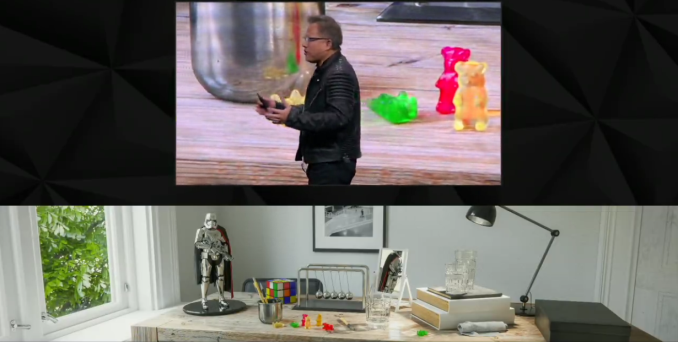

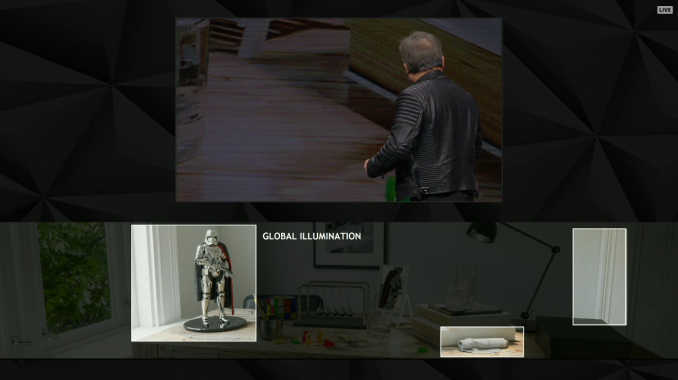
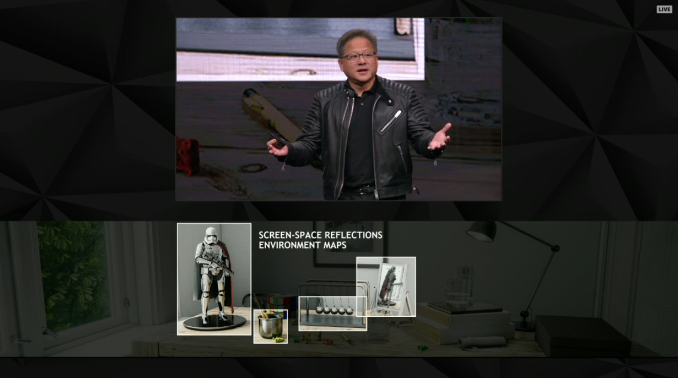
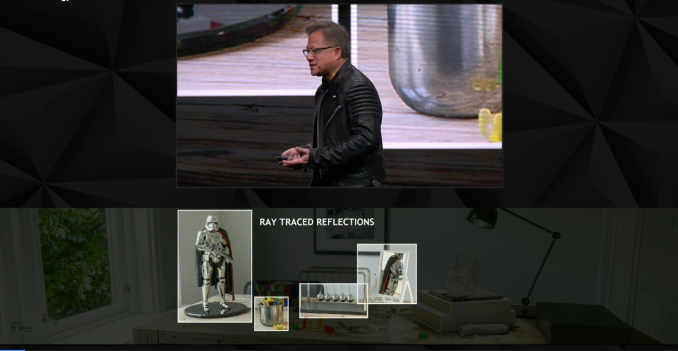
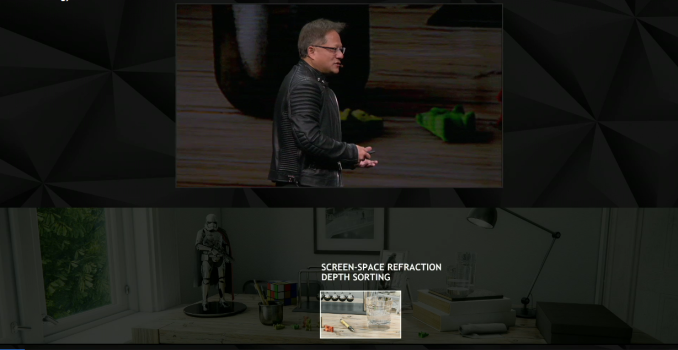
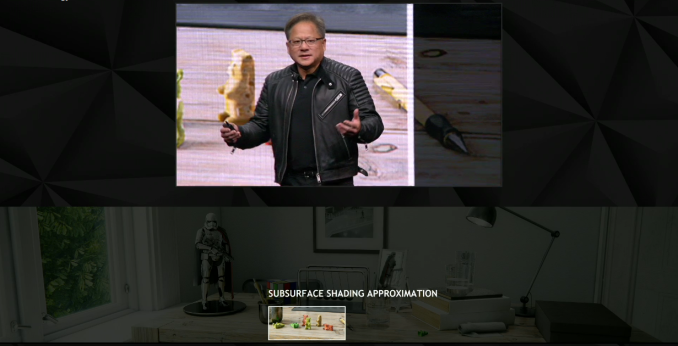



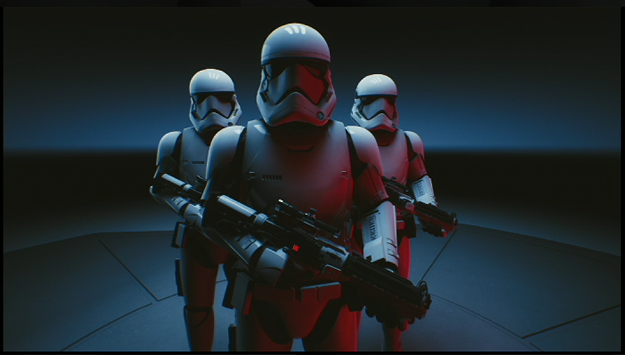
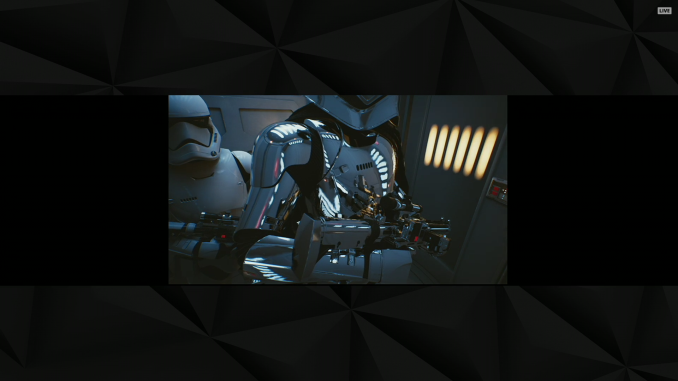
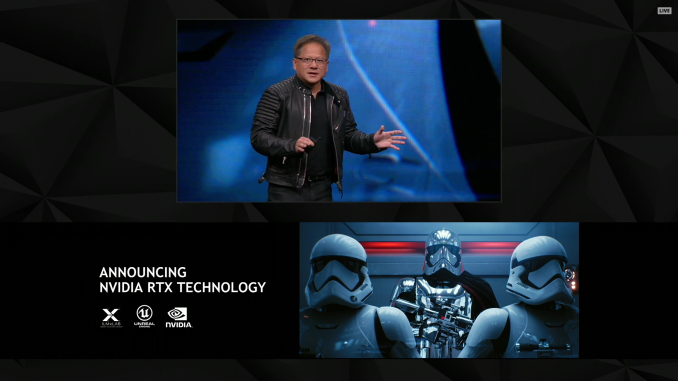
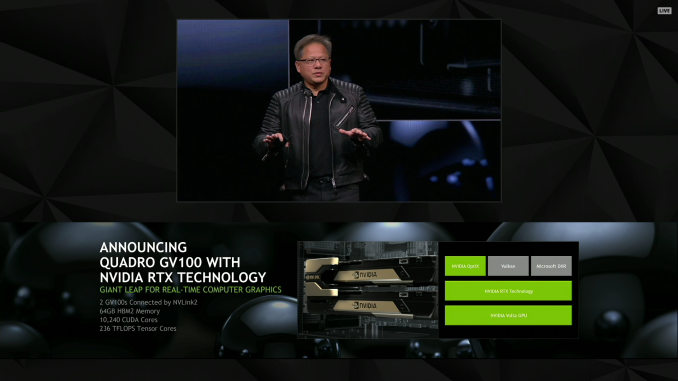
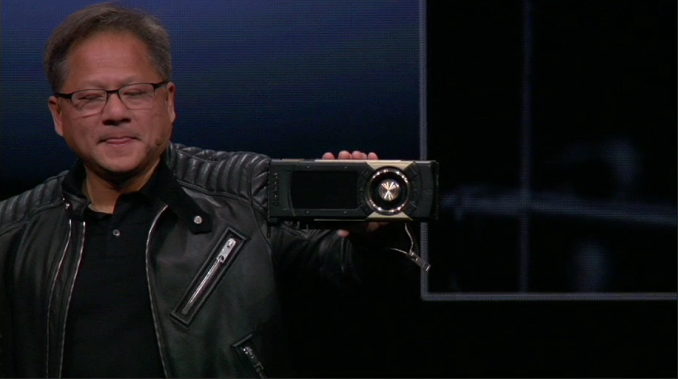
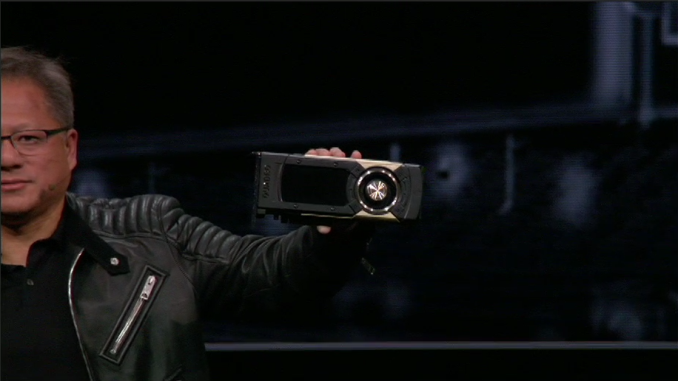

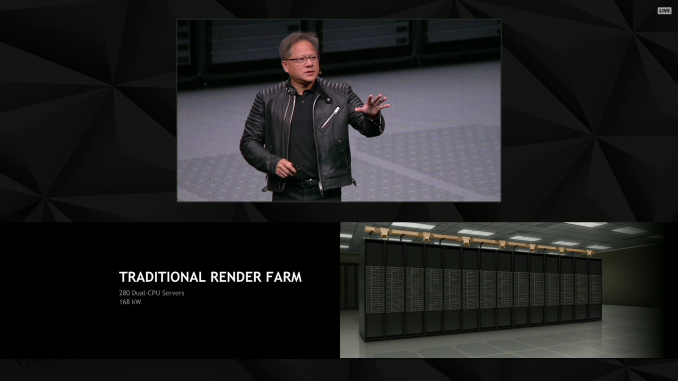
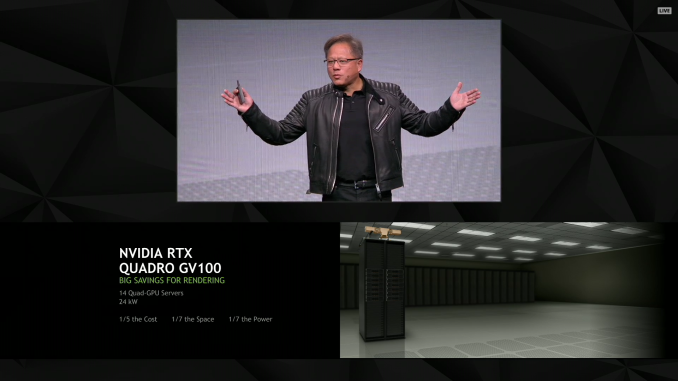
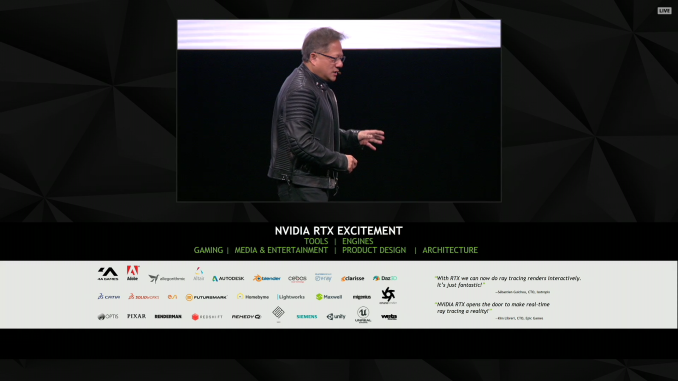


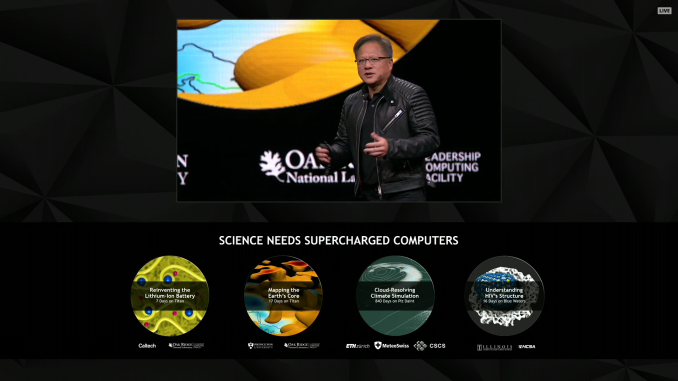
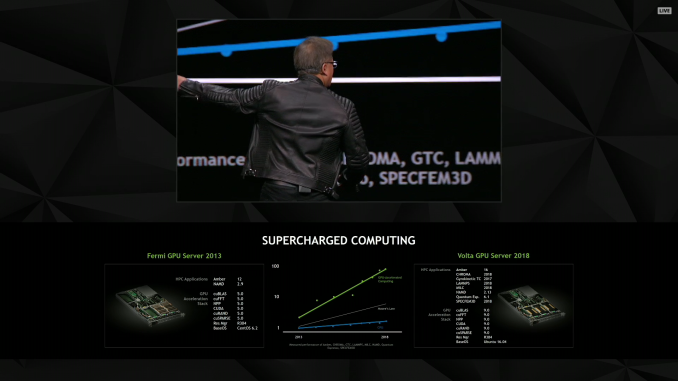
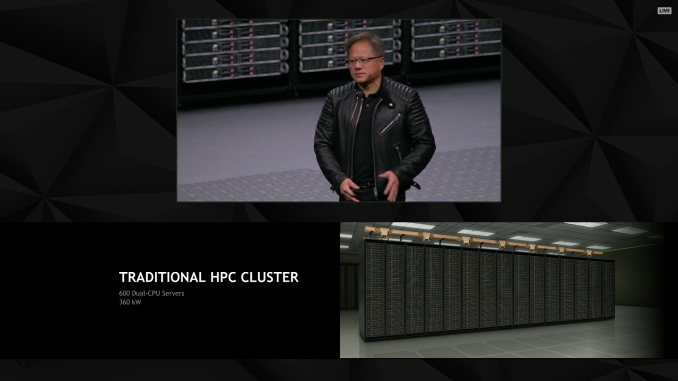
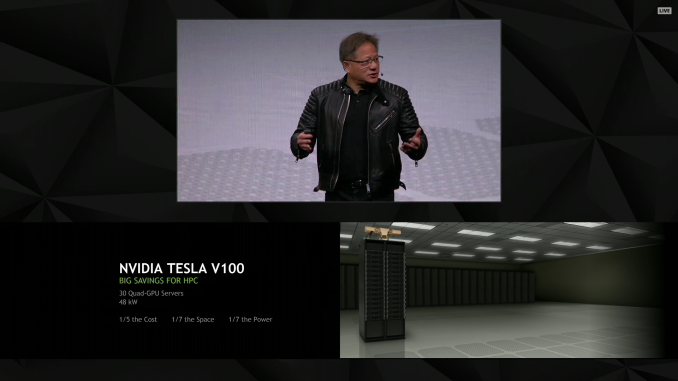
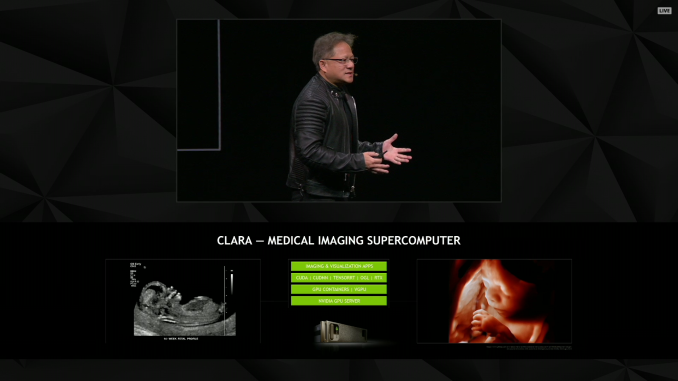
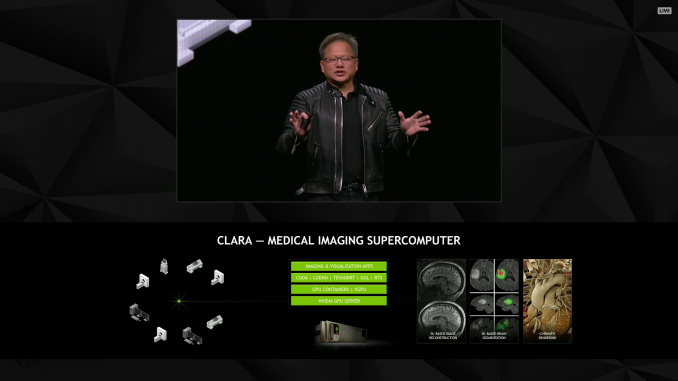
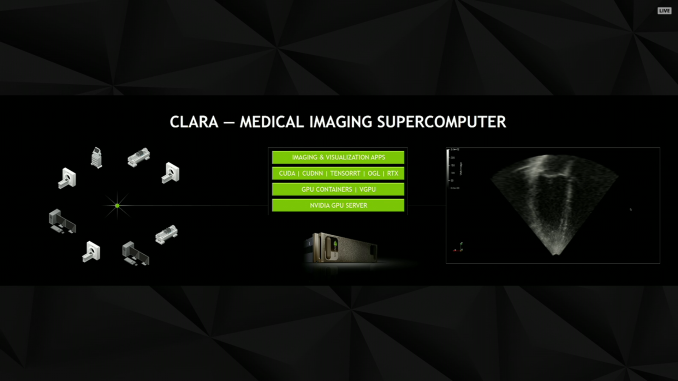
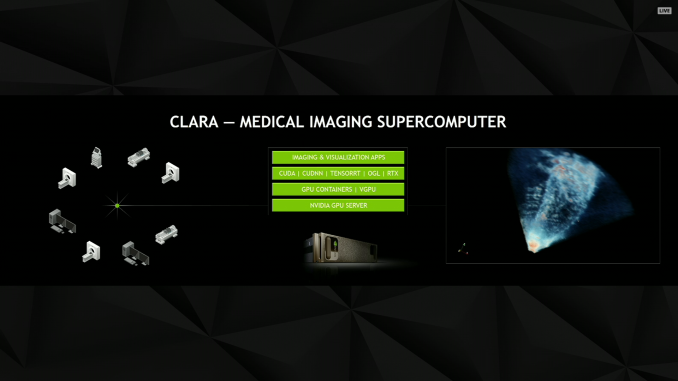

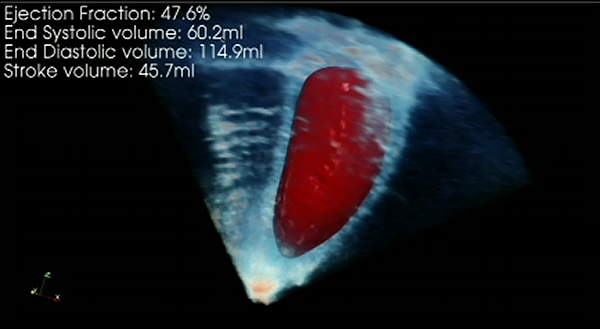
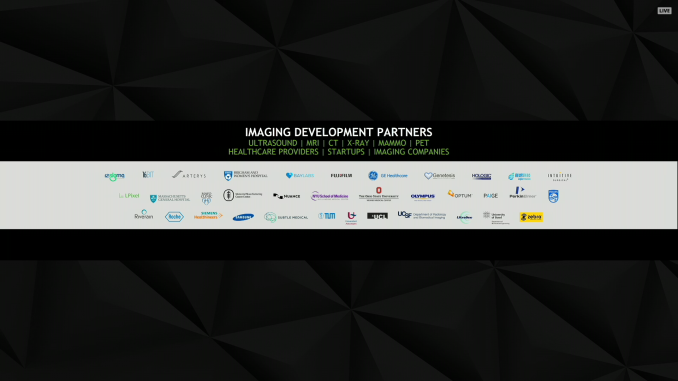
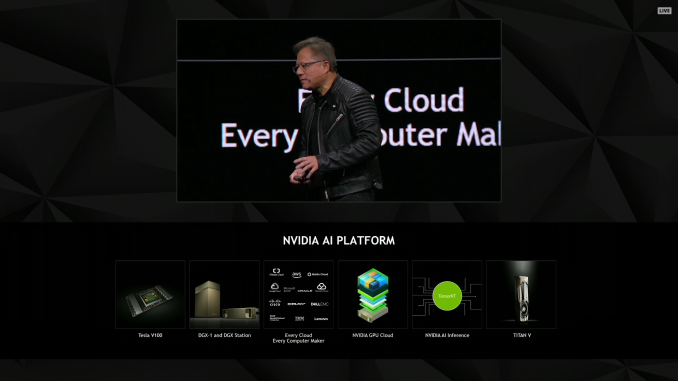
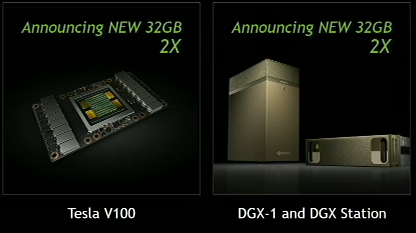
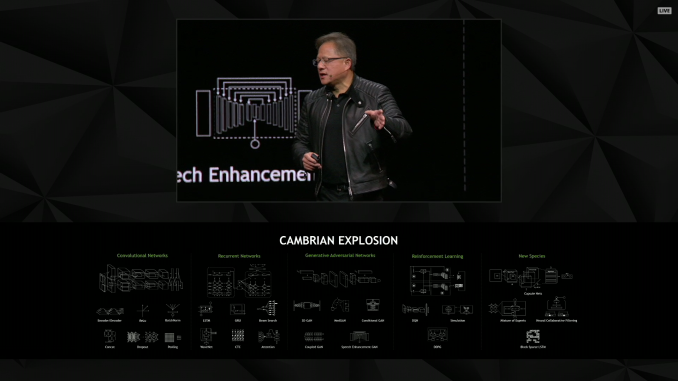

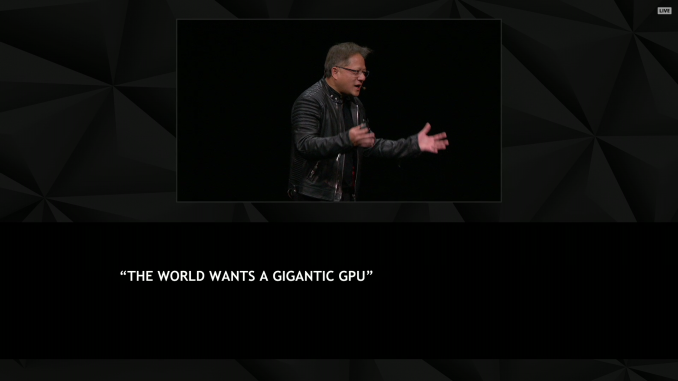
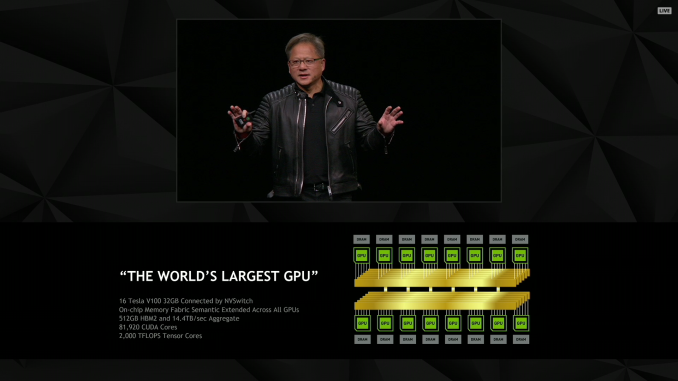
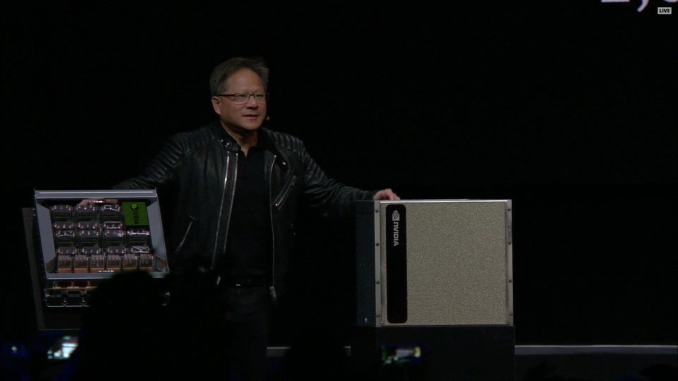
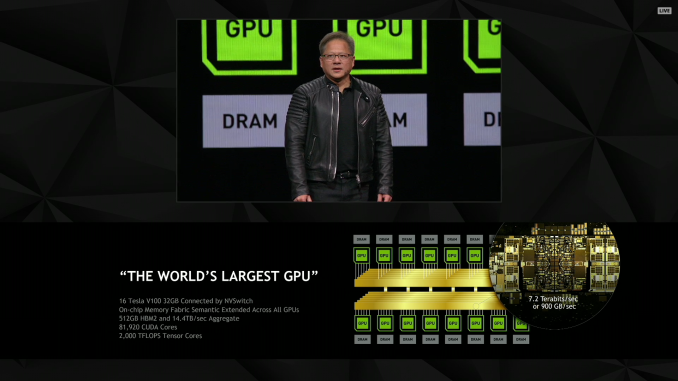
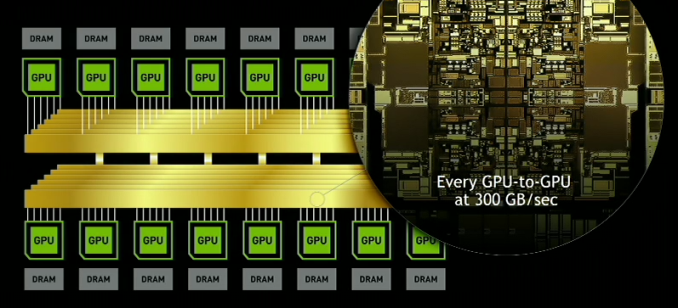
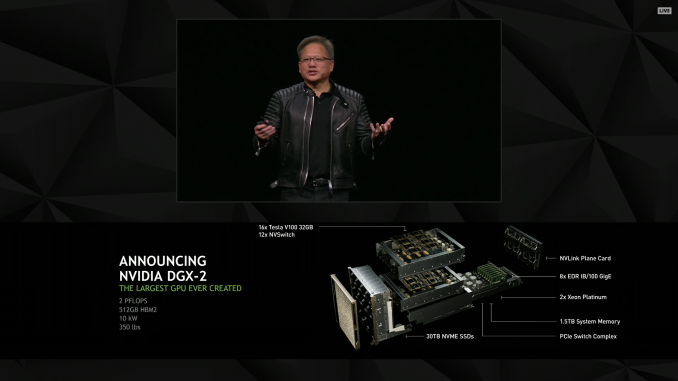


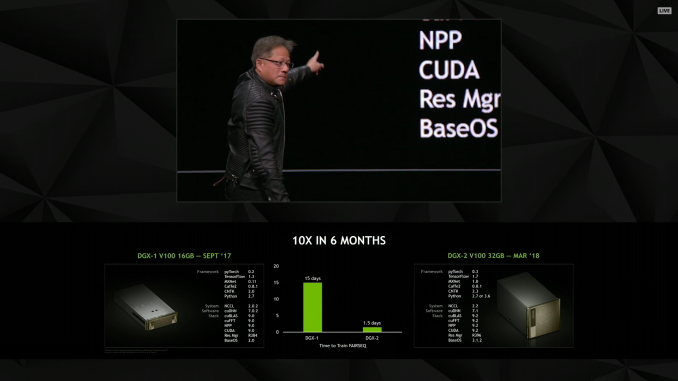
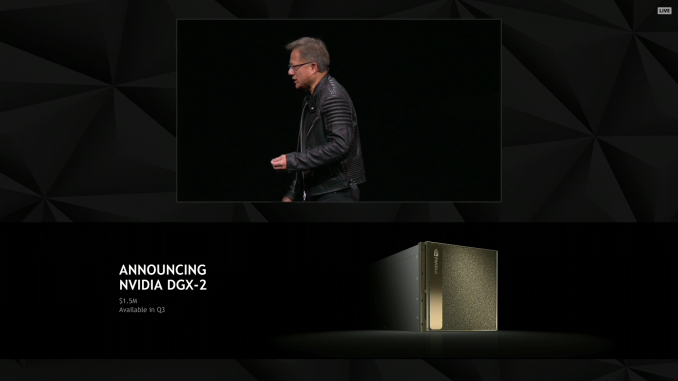
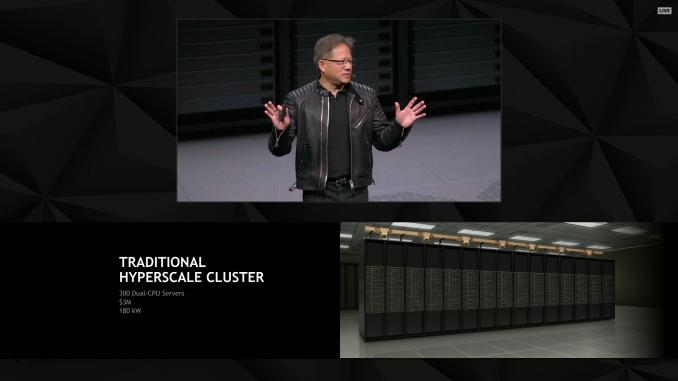
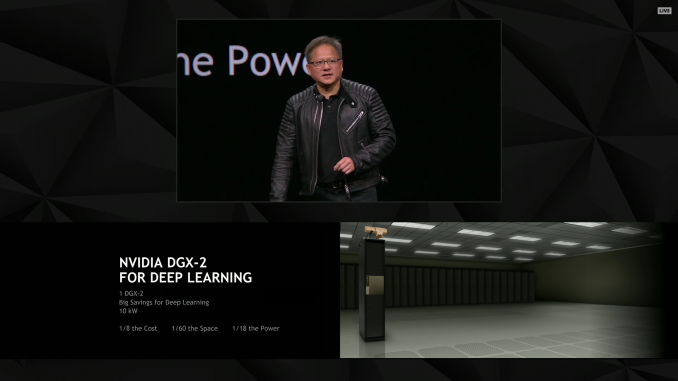
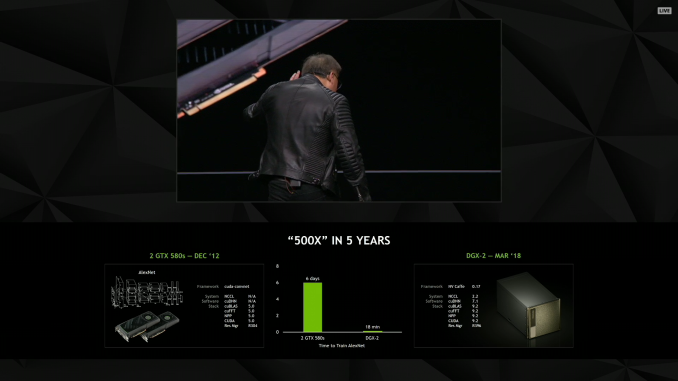
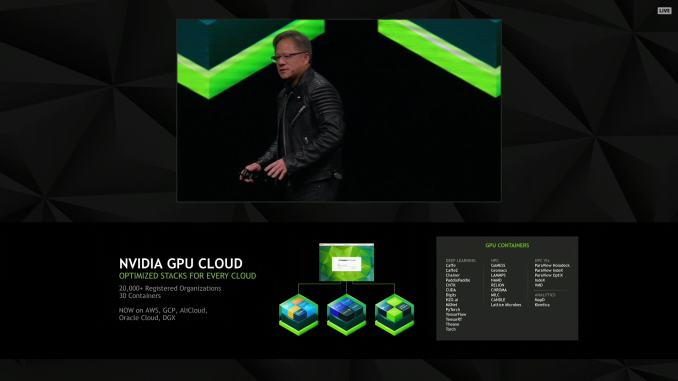
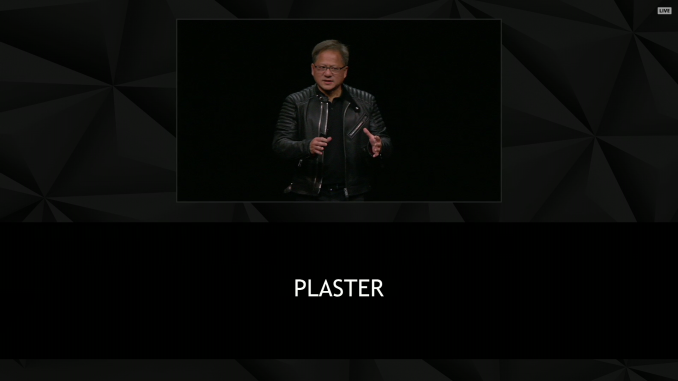
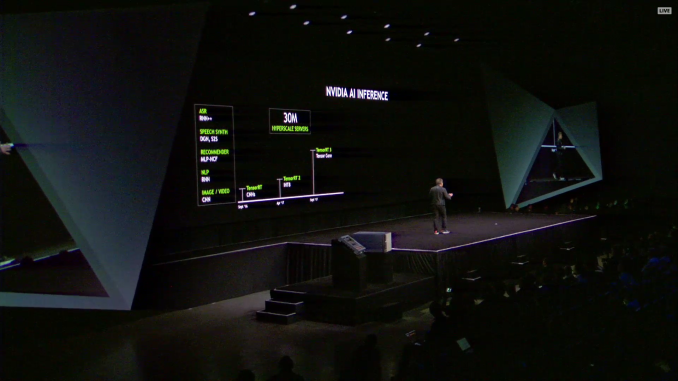
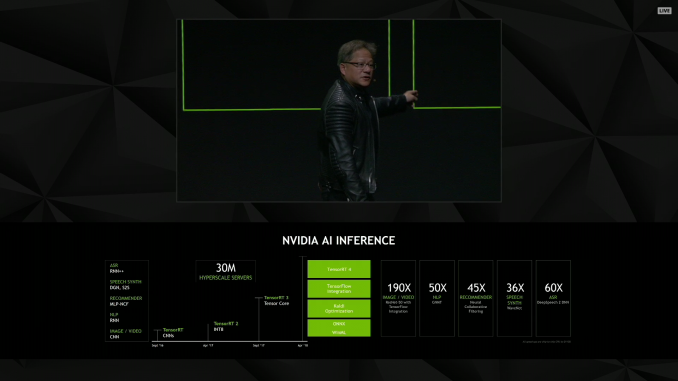
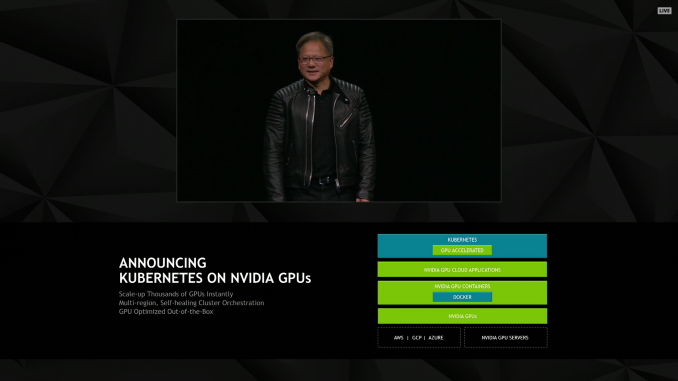

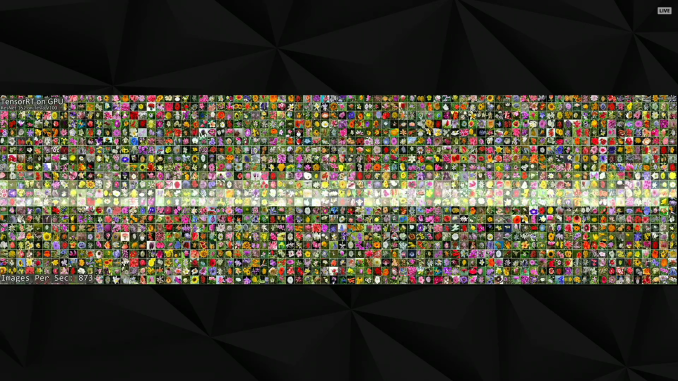
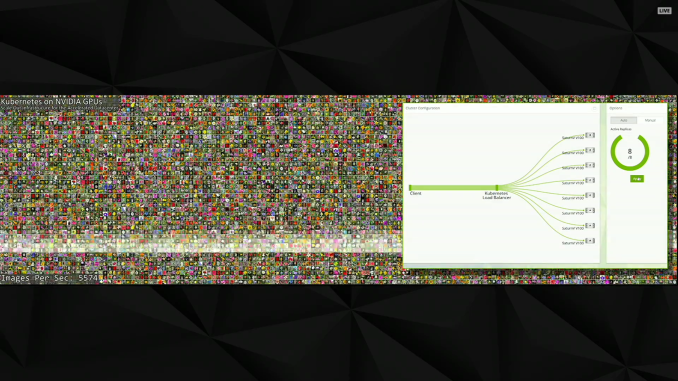
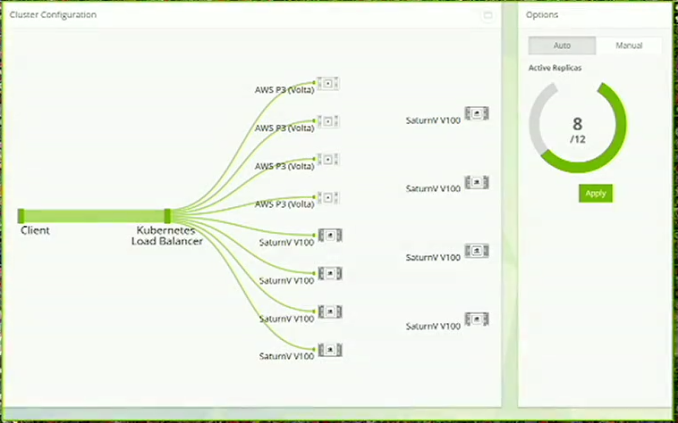
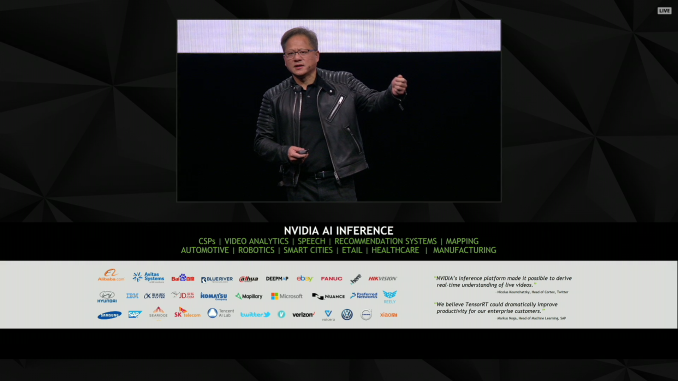
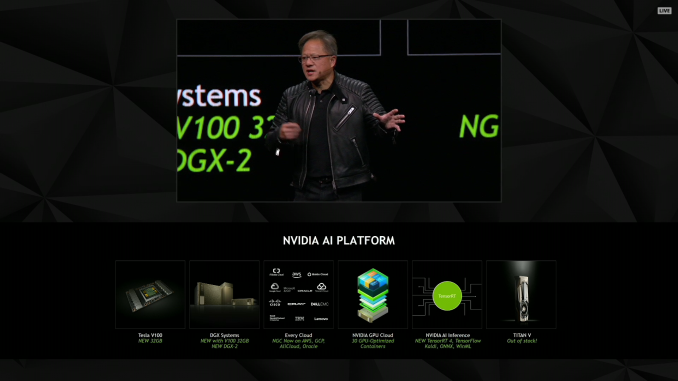
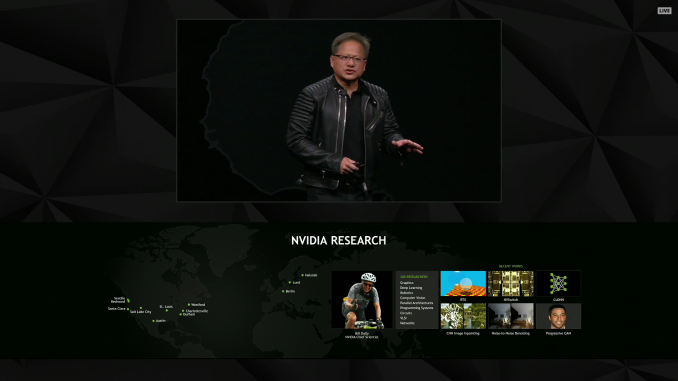
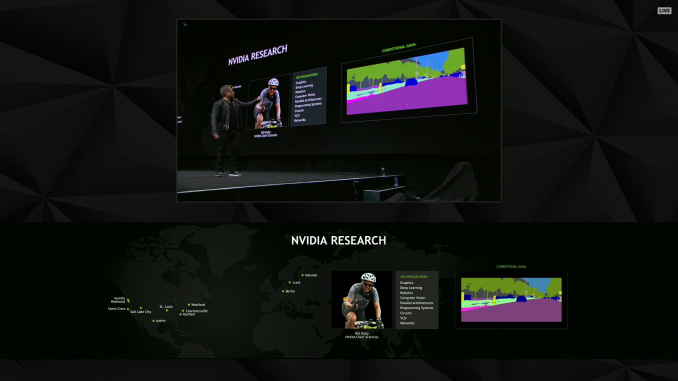
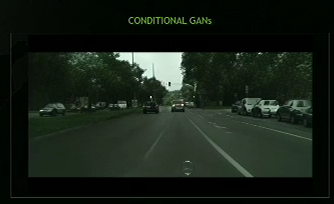
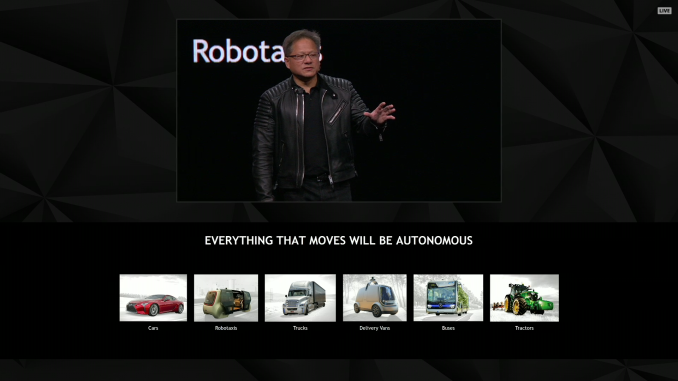
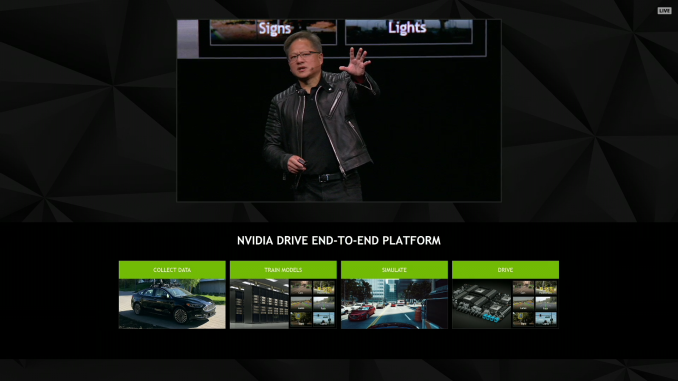
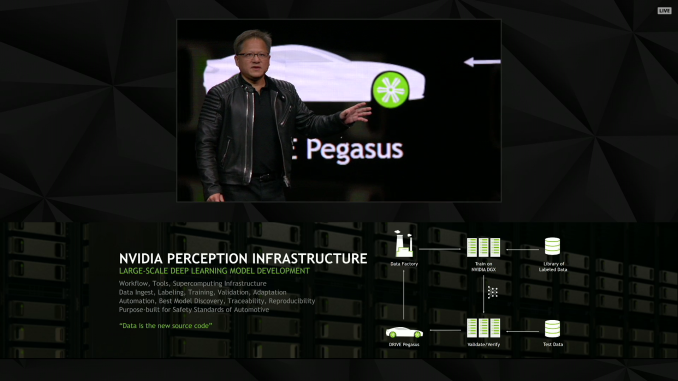

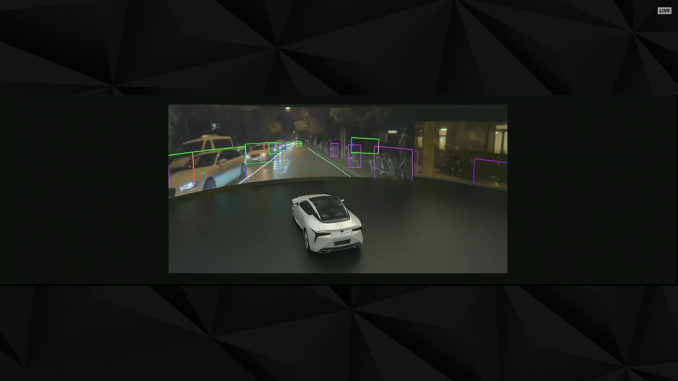
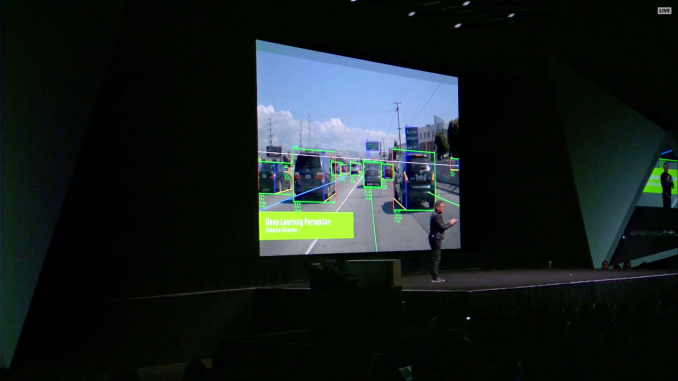
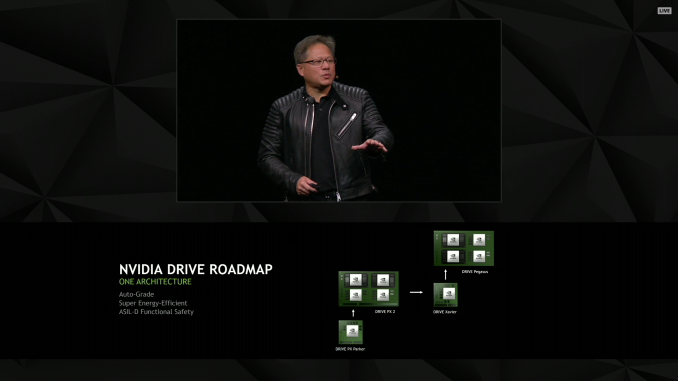
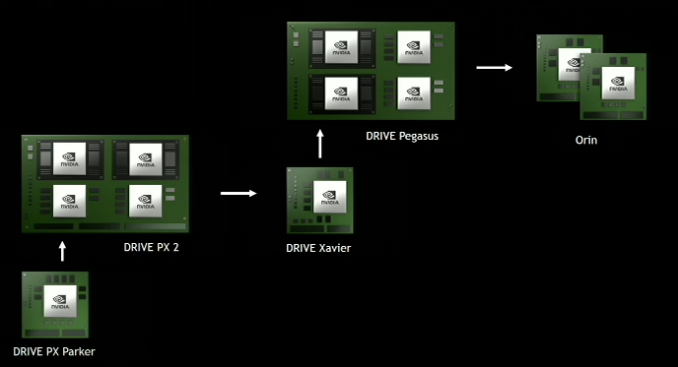
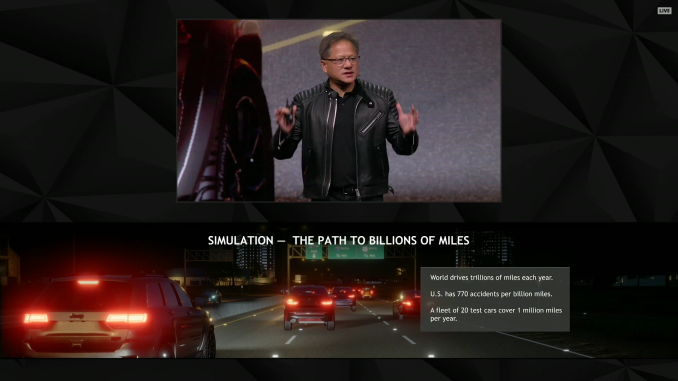
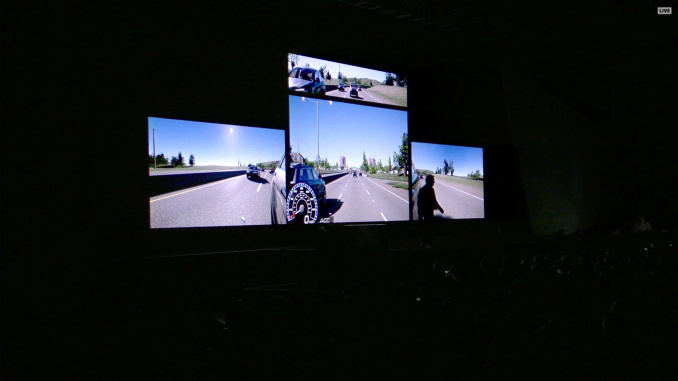
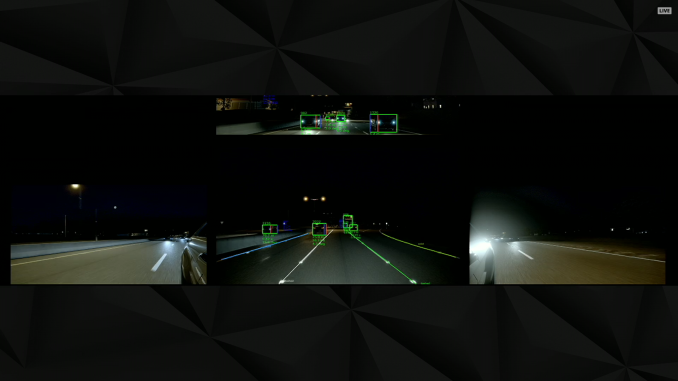
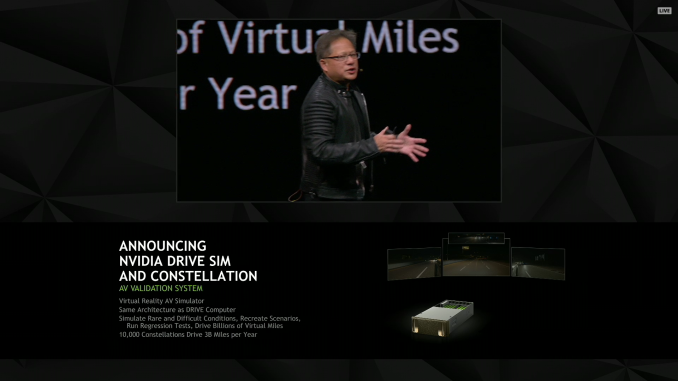
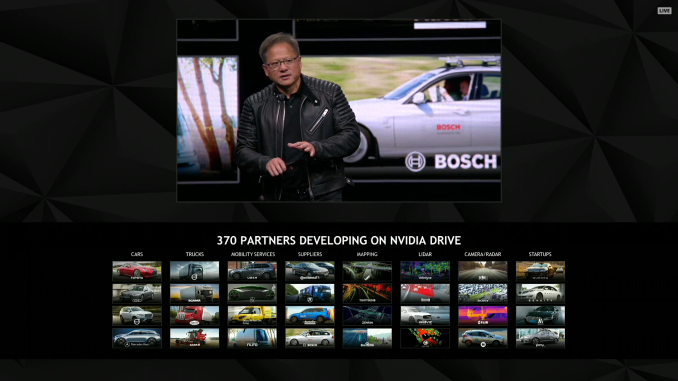
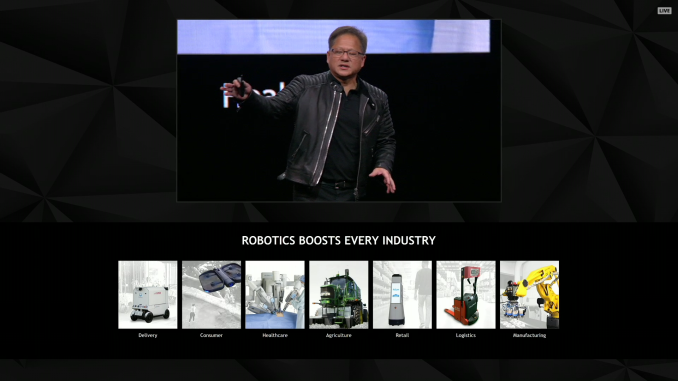
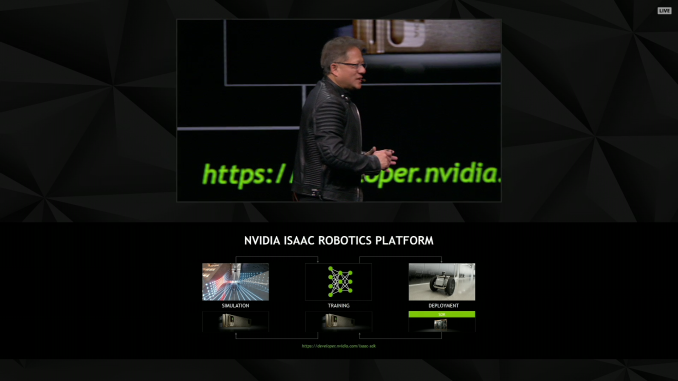
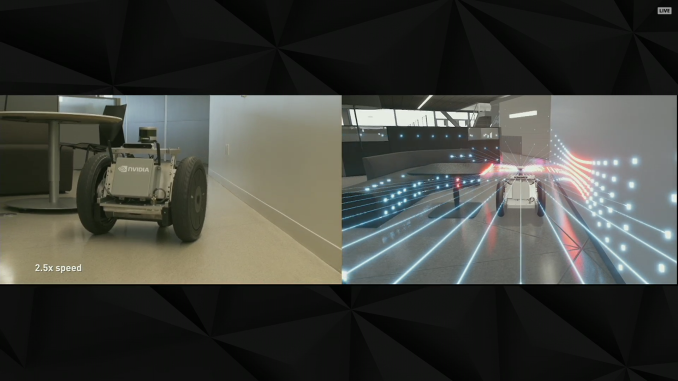
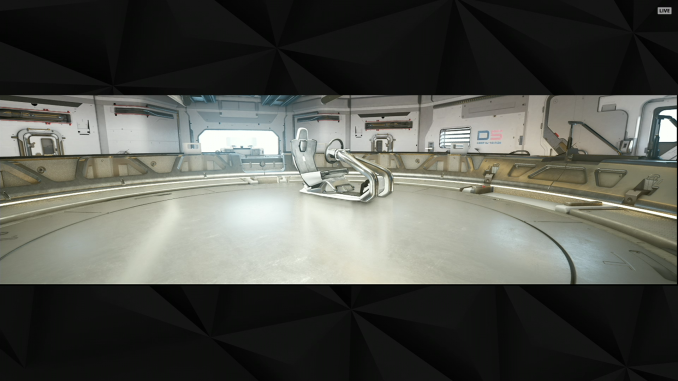
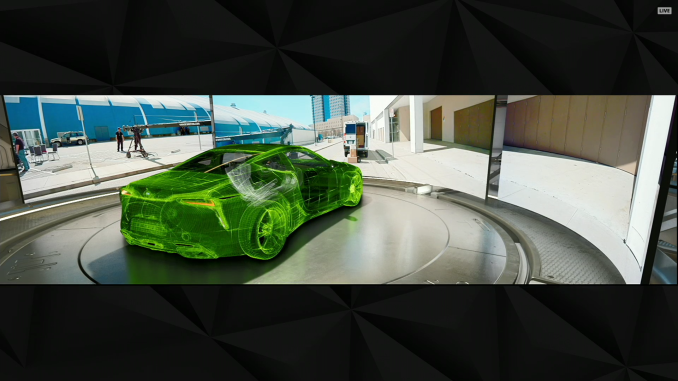
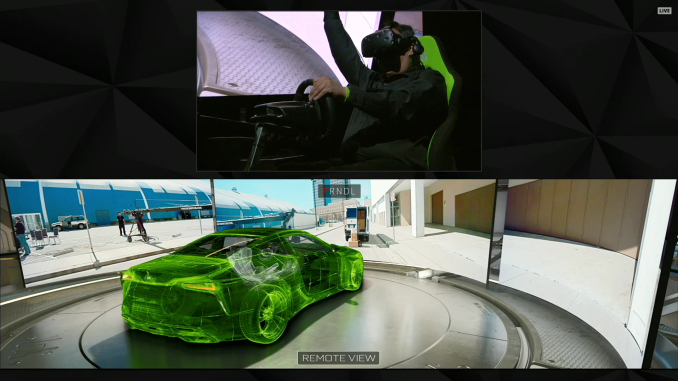
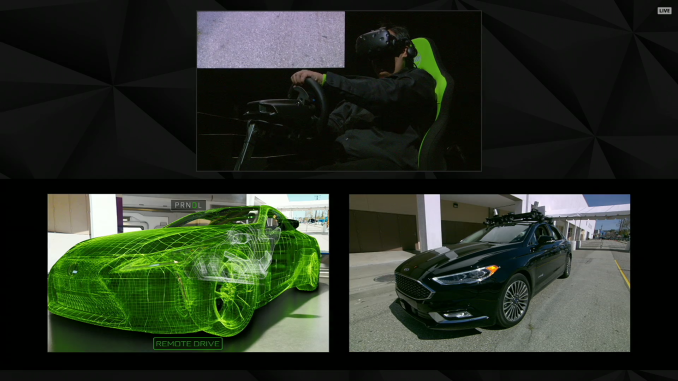
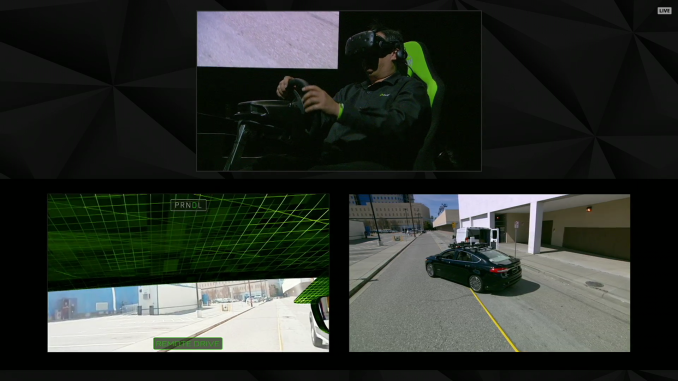
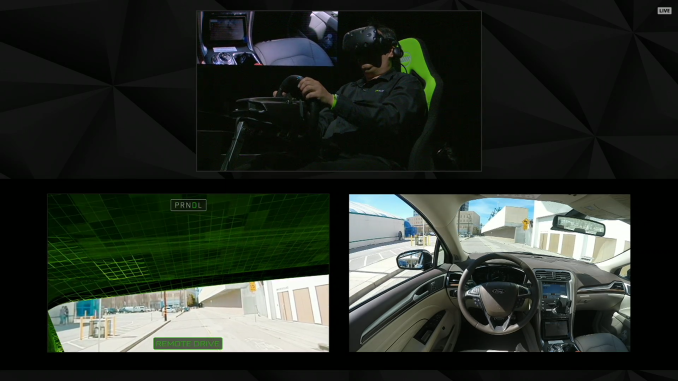
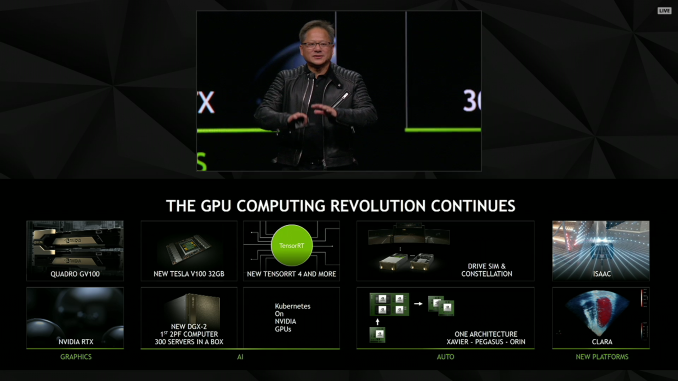








27 Comments
View All Comments
guidryp - Tuesday, March 27, 2018 - link
Only one thing I care about: New GPUs...But sadly, with mining keeping prices high, and supply low, there is little incentive to offer us better performance/$.
willis936 - Tuesday, March 27, 2018 - link
There's a lot of stuff to care about in regards to nvidia right now: new GPUs, supply and pricing concerns related to cryptocurrency mining, and antitrust law violations by way of GPP.All they'll talk about are future driver features that might make reflections look slightly better though.
BenSkywalker - Tuesday, March 27, 2018 - link
Was GPP that program where companies that controlled 81% of PC graphics and 100% of the CPU market colluded for two years(with many predatory monopoly fines levied for one of the companies at the table) and then swapped to brazenly push a smaller competitor out of the market?No, wait, that was AMD and Intel, silly me.
GPP is the program where the company that controls a whopping 18% of the graphics market is offering promotional kick backs to partners for branding purposes to combat the collusion between the predatory monopoly and AMD.
There are many levels of stupid- antitrust laws exist for one reason- to stop monopolies from abusing their power- see the thing that AMD is helping Intel to do. The companies controlling 81% of graphics shipments and 100% of CPU shipments attempting to squeeze nVidia out- that is antitrust violation. Luckily for both AMD and Intel, their tech is so comically bad, even their predatory monopolistic business practices aren't enough to damage the little guy at this point.
artk2219 - Tuesday, March 27, 2018 - link
..... what? I honestly can't understand what you're trying to say, that AMD and Intel working on a few projects together is going to kill "the little guy" Nvidia? The same Nvidia thats actually twice the size of AMD, and that has been working out deals with game companies to make games run worse on their competitors hardware, and that knowingly sold chipsets and GPU's that didn't meet the requirements that OEM's put forth, causing massive recalls? Sigh, troll be trolling I guess. I know none of these three companies are saints, but Intel and Nvidia have done far more shady shit than AMD ever has, and it doesnt bother me at all if all three of them get a slap in the face from time to time, sometimes its needed.BenSkywalker - Wednesday, March 28, 2018 - link
How something makes you feel, doesn't change the law.In order to be guilty of anti trust violations- the company must be deemed a monopoly.
Intel and AMD control 81% of graphics shipments for PCs and 100% of CPUs. They represent a clearly defined and with stacks of case law to back it up- a monopoly. If they do something to push nVidia out of a market that is anti trust.
Nothing nVidia is capable of doing can possibly be deemed anti competitive because they control, at the high end, 19% of the market in play.
This isn't about how it makes you feel. Your opinion doesn't determine legal reality. AMD has been colluding with a predatory monopoly to hurt nVidia.
nVidia could pay game developers to not let their games run on anything but nVidia- not only would that not be considered anti competitive, it is considered standard practice in the gaming world. If *Intel* paid gaming companies to do the same thing, that *would* be anti competitive because they are a monopoly.
When a monopoly does it, it is anti competitive. When a huge underdog does it, it is considered competitive. This is an issue of the law, not your wittle weelings.
FreckledTrout - Wednesday, March 28, 2018 - link
"Intel and AMD control 81% of graphics shipments for PCs and 100% of CPUs." Yes, but the vast number of GPU’s counted for this stat are not discrete. Nvidia continues to hold around 70-75% of the discrete GPU market. I'm saying everything you just wrote is based off poor data and is not true since Nvidia does control the discrete GPU market which is a different market than the APU market. I have no comment on who is doing anything anticompetitive.BenSkywalker - Wednesday, March 28, 2018 - link
Calling actual real numbers poor.....Trying not to come off as extremely condescending here....
The PC market is a major industry and one that is vital to normal commerce throughout the world. Because of this, the players involved are closely monitored for possible anti trust violations. The numbers I used are the actual real numbers for the segment. They are not poor, they are the accurate numbers.
The numbers you are citing are for a sub section of add in parts for luxury(gaming) purposes that are encompassed within the actual data points. Your feelings may tell you they are the important numbers, but that is, to put it mildly, shockingly ignorant when discussing anti trust issues. For real world numbers, you need to use the actual numbers, not just a tiny subset of those numbers that prop up your point.
Anti trust laws don't exist to protect losers in luxury sub categories.
d3mag0gu3 - Wednesday, March 28, 2018 - link
What smaller competitor did intel and amd push out of the market? Cyrix? That happened far, far before integrated graphics were actually implemented on CPU dies. There hasn't been another x86 competitor since VIA bought Cyrix and ran their processor division nearly into the ground.The issue everyone is upset about with GPP is that whatever you might think, discrete graphics are definitely a seperate market from APU's. They are related, but the vast majority of integrated graphics is not used for the same purposes as discrete GPU's and are generally treated as a throw in feature that allows lower-end workstations to exist without the additional cost and power draw of a discrete graphics card.
Comparing discrete gpus to integrated offerings from either manufaturer is a stupid comparison at best. They don't occupy the same niche and don't perform the same function in actual use cases.
NVidia is forcing AMD out of all the luxury gpu brands from most major manufacturers if they want to *keep selling NVidia cards* under those same brands. Owned and built by those manufacturers, not NVidia. They are forcing the AIB manufacturers to play ball, or to lose the ability to sell NVidia chips. Blatant abuse of their market position to attempt to dominate a very high margin segment of computing hardware.
BenSkywalker - Thursday, March 29, 2018 - link
Your entire post is invalidated for anti competitive discussion by your own comment-"They don't occupy the same niche"
Monopolies aren't about "niche" economics. For it to be anti competitive, it has to impact the segment. Like Intel forcing nVidia out of the chipset business- that was anti competitive. Intel was a monopoly, and used that leverage to force a competitor out of the segment(AMD doing the same thing to nVidia would *not* have been anti competitive because they lack anything close to a monopoly). With Intel and AMD combined- they hit the requisite numbers for monopoly of two key components for PCs- and are working in tandem to directly hurt nVidia. It is anti competitive- it would almost certainly hit the courts if the tech weren't so laughably poor.
If everything you are claiming nVidia was doing is true- and to say that as of right now is an absurd list of lies- none of it would be anti competitive by law anyway. nVidia would be *entirely* within their legal rights to tell the OEMs that they can't sell both nVidia and AMD GPUs. Nothing is indicating anything remotely in the league of that has actually surfaced- even Kyle's "evidence" only pertains to marketing dollars for exclusive product lines- all of the documentation provided indicates that companies can still have a line of products devoted to AMD *and* get their promotional dollar kick backs from nVidia.
rtho782 - Thursday, March 29, 2018 - link
GPUs is GPUs.AMD control 100% of the GPU market for GPUs that say "radeon" on the box. Dividing the market to discrete/integrated to support your point is silly, especially when we have discrete class AMD GPUs integrated into Intel CPUs now.